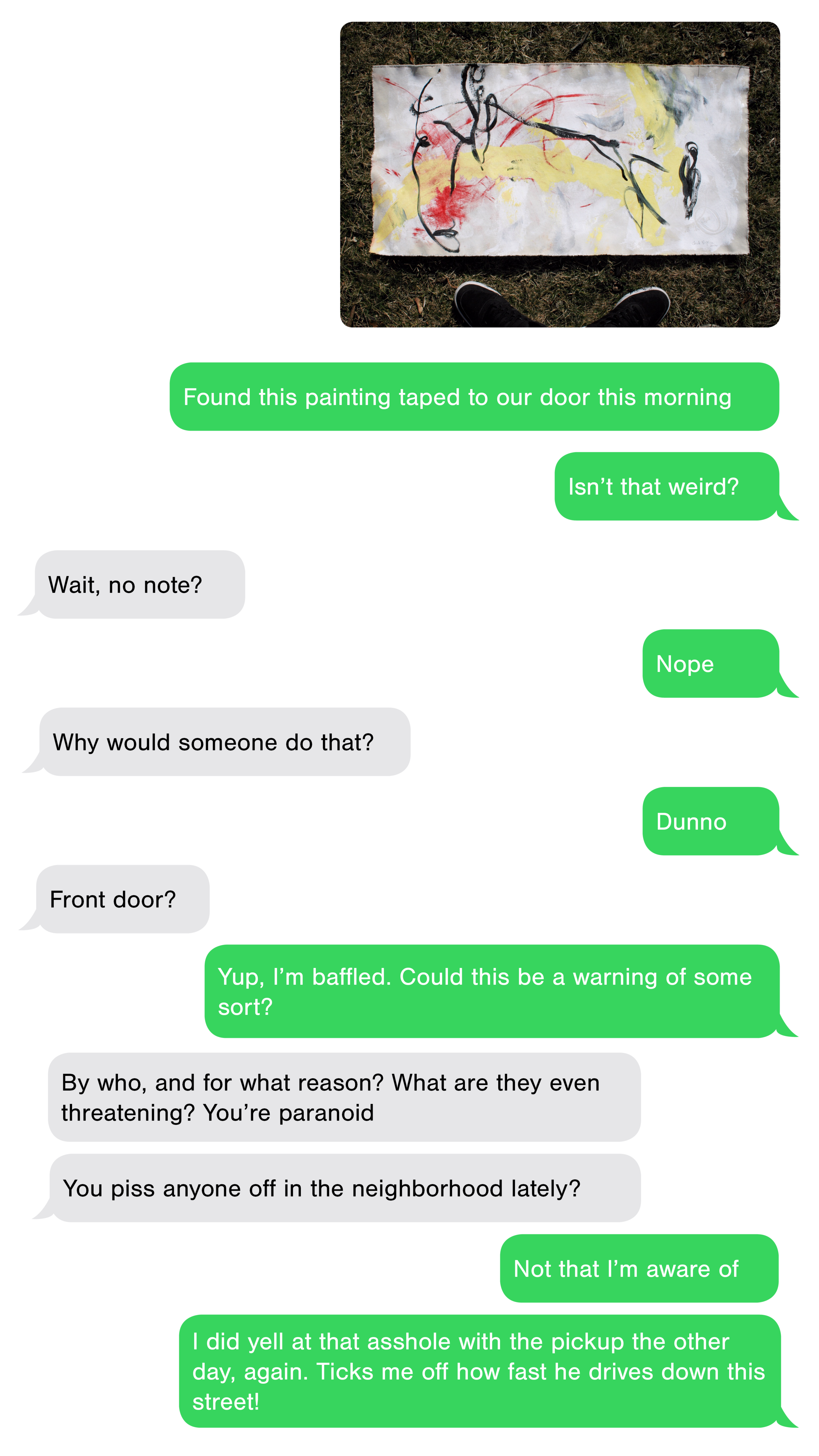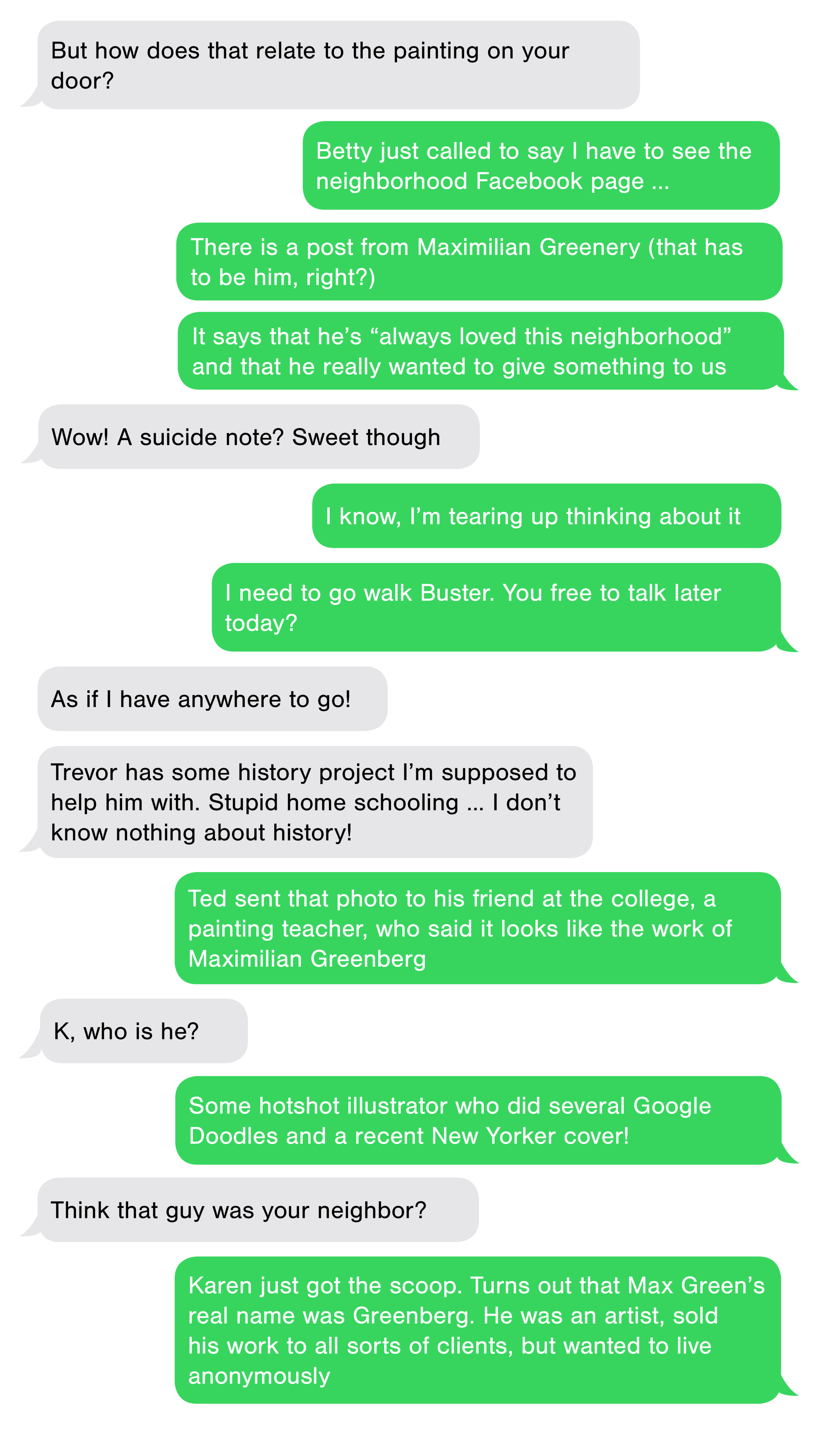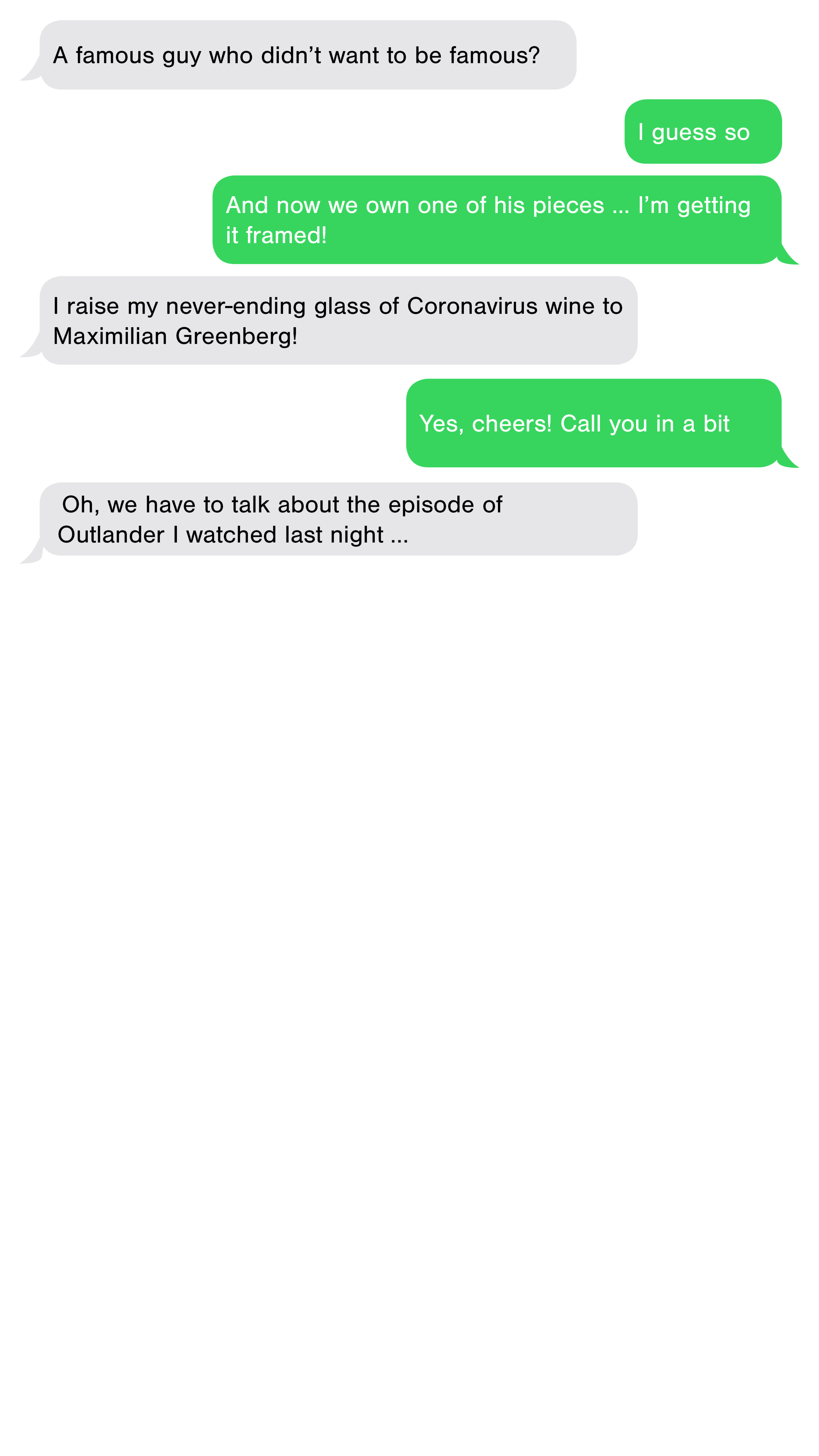Taped To Our Door
Bob Gielow
“It just felt very comfortable to have this be a messaging-based narrative.”
Interview by L. Valena
First, can you describe what you responded to?
The first think I noticed when I saw the image that you sent, was that it wasn't just an image. It was a photograph of some artwork. And in the photograph, there were shoes and grass. That kind of put me in the mindset of a person who's looking at this piece down there at their feet. And I thought- what would be the story behind someone with some artwork at their feet? I envisioned that it just sort of appeared to the person who took that image, and went from there.
What happened next?
Then I had to think about why would this artwork appear to someone for the first time. Maybe it really was a surprise, and it was taped to their door. And then I had to figure out why a piece of artwork would get taped to your door. Sometimes when I write stories, I get an idea, and then I follow it along a little bit, and realize that there's no good reason this would happen. No compelling, interesting reason that this would happen, so I have to abandon the idea. But I liked the idea that somebody from the neighborhood might tape it to their door, and the person receiving it would have to kind of sleuth out how it happened, and why it happened.
There might be some people in the neighborhood who, if they got a piece of artwork, they'd just throw it away. But this person was curious, and had a partner in crime that they were texting with. And I guess that's the other thing that immediately appealed to me- how do you tell this story? It's 2020, and the way people communicate is through text, emails and other things. I thought that a text exchange might be a good way for the recipient of the artwork to explain what happened. And then, you probably noticed, the non-recipient was the one who was asking most of the questions. They drove the sleuthing along.
I love the format- I think that a text exchange as a format for writing is just really cool. I know you've done some other work like that, and I think it's a really interesting format.
Because of my reaction to the image I got, and seeing the feet in it, that put me in the mind of the person who's looking at this image, saying to themselves, "I just got this, what do I make of it? Where did it come from?" To talk about that curiosity, that human desire to understand what's going on around us, and how they end up the way they end up. It just felt very comfortable to have this be a messaging-based narrative.
We live in a time where most things are google-able, and everything that's not google-able is something that we usually have to talk about with someone else. And if that person is not near us, then we have to text about it to figure it out.
Right. I feel like there might be some people who would get on the phone right away, and say, "Guess what happened this morning? I got this thing!", and then they'd have to describe it. But the text messaging was sort of the obvious way to start. If you make it a phone call, you can't send an image to accompany the conversation. I mean, what would you do? Especially in Covid-time? I had to think about how paranoid might this person be? How fast will they get the information that explains what happened?
When I started, I thought to myself that this was a neighbor who had put it on the door, but I didn't really know anything else about it. I hadn't really thought about what would have motivated that person to do that, I just knew that, as I got into it, a motivation would come to me. And it did. That's what creativity is- you sort of think stuff up, and think hey, that could be kind of fun! That might make sense. I don't want to write something that's so far fetched that someone reads it, and says no that just wouldn't happen. There's gotta be a little bit of an air of plausibility. Notice I said “a little bit”.
I had a moment while reading this, when it said that he had said on the Facebook page that he wanted to 'leave something' to the neighborhood that meant so much to him. Oh my god, did he, like, lick the paintings? Is everyone in the neighborhood now going to get Covid because they've been handling this guy's infected artwork? Is that what he's 'leaving behind'?! It seems like that wasn't the intention, but isn't it funny that my mind went there? That's the level of paranoia and agoraphobia we're all dealing with right now.
That's the kind of feedback that could come out of a writer's group that could make a little short piece like this even more interesting. Just to explore that a little bit- I very much like that idea. I'm sort of curious about your reaction, and how you envision the neighborhood, because as you might imagine, I was envisioning the Atlantic Heights neighborhood, which you obviously know.
Yes, that's what I was envisioning too. It just seems totally plausible for something like this to happen in Atlantic Heights. There are so many amazing characters in that neighborhood, it totally makes sense that some famous artist could live their anonymously.
Yeah. And obviously there are plenty of neighborhoods that have some cohesiveness to them, where neighbors talk and they share stories about each other. And they have conversations about that jerk who drives too fast. Stuff like that.
I definitely think this piece has a sense of place to it, which is really cool, especially since the picture is not from that neighborhood. That grass is not in Atlantic Heights!
Can you talk about how this relates to the rest of your work?
I'm not sure if I can. I like writing in alternative formats, I just like the voice that's created when you write in diary entries, emails, text messages, or wikipedia posts. It certainly fits with that theme. It's not quite as smart-assy as some of my other works. Towards the beginning of the quarantine, I wrote a fictional press release for a company letting folks know how they're responding to the coronavirus. Everyone who has any connection with any corporate entity is getting emails every day like that. I get a kick out of unique formats of communicating ideas, so I took that desire and applied it to this situation.
Do you have any advice for someone else is going to do this?
I think my advice is similar to other artists giving advice to other artists. Trust your instincts, don't try to write what others expect of you or want from you. Don't try to mimic someone else. If the prompt is to respond to this piece, listen to what your head and heart are saying, and respond to the piece that you're given. Listen to yourself, listen to your reaction, and go with it.
I have to admit, I was a little nervous about some of the things I said in my piece. There's that one part where one of the characters said their kid could have made that when she was three. I worked at an art school, so I know that's how some people react to abstract art. I was a little bit nervous about doing that, but I realized that I couldn't completely change the path I was going down if you think there might be some cringing that occurs. If that's what you want to do, gotta go for it. Some people might like it, some might not like it, but you're putting yourself out there.
I loved what that line did to kind of illuminate that character. It's such a classic scenario. Someone says a piece of art looks like a three-year-old made it, someone else turns around and says it's by a famous artist, and then the first person says, "Oh, it's amazing!"
It says something very interesting about humanity- about human beings. I'm not sure if it's a herd mentality thing? If all these other people think this is cool, then it must be cool.
Sometimes I feel like it's almost a self protective thing. We don't want other people to think we're stupid. Saying that you like something is so vulnerable.
Something that I've heard from some people who participate in Bait/Switch, is that because they don't have any context for where this work is coming from, they don't know what to make of it. It's interesting how important context is in finding meaning in things.
During this process, there were a number of times where I thought to myself, if I knew who did this, I might see elements of their personality or proclivities. Do they always like to use certain colors? But that's how we get along as humans. We look for trends, we're trying to simplify this crazy world around us, so we look for themes, consistencies. So knowing the person who made the piece can help you, and it's very interesting to not.
Is there anything else you want to say about this piece or about this process?
It was kinda fun to play with what often happens in human interactions, which is those little tangents that are taken. We're talking about the painting, but now we're talking about the shoes. That's how we are. Hopefully there's at least a little bit of rationality in a conversation, but oftentimes it pops around here and there.
Call Number: Y31VA | Y32PP.gieTa
As a college administrator for over 30 years, Bob Gielow spends most his waking hours wordsmithing non-fictional email messages and policy/process documentation. During the weekends, he prefers taking walks with his family (and Sophie Fiona the dog), eating out and wordsmithing fictional short stories using non-traditional formats.







